BG4: “Someone to Watch Over Me”
By: Bear McCreary
Date: February 27, 2009
Source: Bear McCreary’s BSG Blog (HERE, HERE and HERE)
Note: This is a snippet from BEAR McCREARY’s blog where he mentions AARON DOUGLAS / CHIEF TYROL. To read the full blog entry, click HERE, HERE and HERE.
BG4: “Someone to Watch Over Me,” Pt 1
Bradley Thompson added “We had some idea it would be a Starbuck vehicle, and we had some notion that we’d get to do Boomer/Tyrol, but we definitely knew that given the choice, we’d sing our swan song with Michael [Nankin].”

“I remember you talking about Gershwin in our conversations,” Weddle recalled. “So when it came time to come up with a title for the episode, I looked up Gershwin songs and found ‘Someone to Watch Over Me.’ I ran it by Brad and he said, ‘Jesus, that’s perfect! Not only for the Kara story, but for the Tyrol/Boomer story as well.’ Brad was primarily responsible for writing the Tyrol/Boomer story, so that became a seal of approval.”
BG4: “Someone to Watch Over Me,” Pt 2
I also performed additional pieces at the request of Michael Nankin. “I also started having ideas — which developed during prep and the shoot—about using Slick’s compositions as score for other scenes,” Nankin explained. “In my shooting script I’d drawn lines from piano scenes, extending over the next two scenes (or the previous two scenes,) indicating where this would happen. I started talking to Bear about this in the early stages, so that he could write to it, essentially scoring the episode before it was shot. The episode contained stories that were very different in tone (Starbuck’s visitation, Tyrol and Boomer’s cylon projections, the plot to steal Hera, Adama and Laura saying goodbye) which I felt this approach to the score could smooth out. I always attack an episode with the idea of making it all of one thematic and emotional piece, rather than disjointed A, B and C stories.”
Nankin showed me these specific scenes in the script he wanted music for and I played them out in my mind, performing score that I thought would be useful in the cutting room. It was strange, to “score” scenes that hadn’t been edited (or in some cases, even shot) yet. Supervising editor and associate producer Andy Seklir was also on set, so I was able to discuss these pieces with him as well.
I performed solo piano versions of “Roslin and Adama,” Tyrol’s Theme and Starbuck’s Theme and anything else I thought might come in handy. (And since you’re wondering, the entire Roslin and Adama subplot was cut out of the episode, so I hope you can see these scenes on the DVD set.)
BG4: “Someone to Watch Over Me,” Pt 3
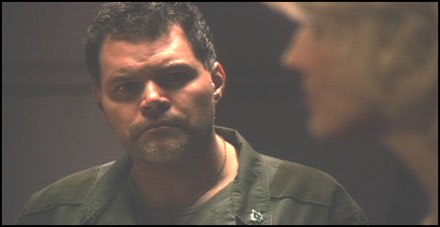
Before the teaser ends, we begin the episode’s other plot line. Chief Tyrol learns that the cylons wish to execute Boomer for her role in the cylon uprising. At the moment he realizes this awful truth, listen for a subtle statement of the Boomer Theme in the gamelan:

This theme is one of the oldest in my toolbox and, in combination with the Tyrol Theme, will play an important role in their arc this episode.

At the end of the B Theme, we cut to the Chief’s storyline. He’s welding in a hallway, but thinking about his past relationship with Boomer. Here, the score takes an interesting turn. We are no longer in Joe’s Bar, and yet we continue to hear Slick play the piano. But, it moves from the physical space of Joe’s Bar to sounding like it’s in a concert hall. It has, in essence, transitioned from being a real instrument in the ship, to a part of the score itself.
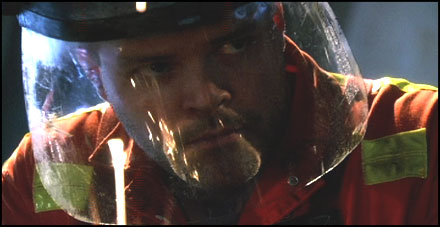
While the Tyrol Theme would have been an obvious choice for this montage, I felt it was more important to establish the piano music as a thread tying this episode together. So, Slick’s piano plays the Sonata A Theme throughout the entire montage, although joined by percussion, yialli tanbur, duduk and the other BG score instruments.
At the end of the montage, we again witness Boomer dying in Chief’s arms and the piano slowly echoes away, playing an ascending figure that we will hear again when the Chief / Boomer storyline reaches its climax at the episode’s conclusion.

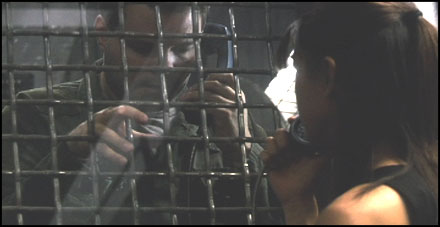
From there, we cut to the first big step in the Chief / Boomer storyline. He goes to the brig to visit her and has an unintended projection, taking them to the dream house they never had the chance to build together. In this scene, Chris Bleth plays the Tyrol Theme on the alto flute:

This theme has an interesting and convoluted history. I originally composed it for Season One’s Litmus, intending to write the definitive Tyrol / Boomer Love Theme. However, unbeknownst to me, they had no more love scenes in the season, and she was killed early in Season Two. At the end of Season Two, I re-tooled the theme to serve as a Tyrol / Cally Love Theme, underscoring his heartfelt apology to her for breaking her jaw. After occasional uses in Season Three, the theme was basically put to rest when Cally died in Season Four.
However, in Someone to Watch Over Me, the Tyrol Theme comes full circle and again functions as the Tyrol / Boomer Love Theme, just like I’d originally intended.
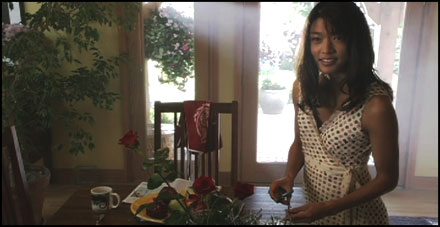
After his initial bad projection experience, Chief comes back and tries it out again. This scene represents the most complete, lyrical and romantic version of the Tyrol Theme since their relationship together at the end of Litmus. The simple arpeggiated accompaniment in the gamelan, piano and harp is also a reference to that Season One cue.
Chief walks through their dream house, basking in every last detail. However, he’s surprised to see a growth chart on the wall for what must be their child together. At this touching, suspenseful moment, the Tyrol Theme is played by an ethereal piano… Slick’s piano! I did this to further blend these two storylines together, as if Slick were in the score as well, commenting on the Chief’s discovery of his daughter.
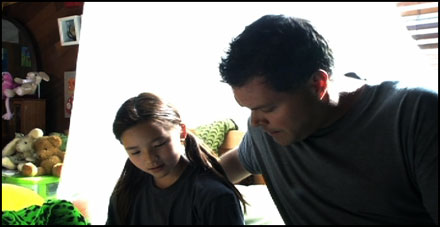
And what a discovery it is. As he moves up the stairs, the score modulates upward and swells to a big statement of the Tyrol Theme in electric violin, erhu, duduk and bansuri accompanied by gamelan, piano and harps. This kind of romantic musical gesture is rare on Battlestar Galactica, but the incredibly moving performances from Aaron Douglas and Grace Park allowed for me to write bigger musical gestures.

We return briefly to Chief’s storyline. Roslin informs him that she’s releasing Boomer to the cylons, and he doesn’t take the news well. He decides that he must rescue her. The cue underscoring this decision begins with low strings, synths and frame drums, a very typical Battlestar Galactica texture. However, as he puts his plan into action, Slick’s piano sneaks into the score, playing arpeggiated phrases against the ever-intensifying percussion backdrop.
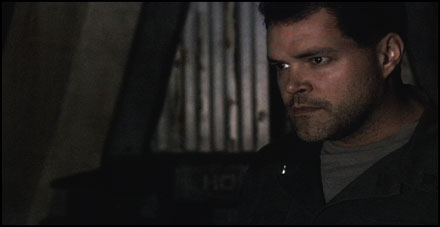
Chief turns out the lights in a hallway where cylons are working and clubs a Sharon over the head with a wrench. At this point, the piano accelerates out of control. It breaks free from the percussion groove and takes on a life of its own.

With Slick coaxing her along, Kara begins to noodle around on the keys, struggling to bring the melody up from her oldest memories. These shots are inter-cut with Boomer retrieving Hera from the nursery and sneaking her aboard a raptor, unbeknownst to the Chief who is helping her escape. Throughout the whole montage, the mysterious piano strains slowly become more and more familiar, underscored with a haunting bed of strings and synths.

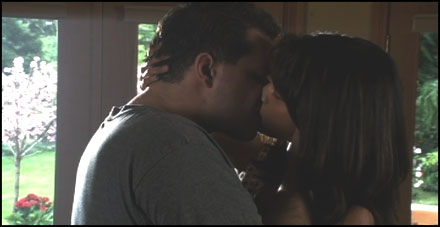
From the climactic moment of Kara’s storyline, we cut back to the Chief and Boomer one last time. He helps her aboard the raptor and kisses her. Even though the audience knows that Boomer is kidnapping Hera, the Chief is totally ignorant of this, so the score comments only on his emotions. We hear one last warm statement of the Tyrol Theme as they kiss, before the score takes a detour into more tense and dissonant territory.

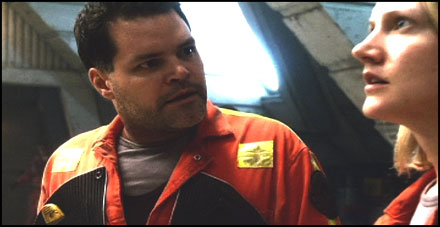
After the pandemonium, Chief Tyrol discovers that he inadvertently helped Boomer kidnap Hera. Here, Chris Bleth’s also flute states a creepy version of the Tyrol Theme against shifting, minor chords. This is his darkest moment, and thusly the most dissonant arrangement of his theme yet.

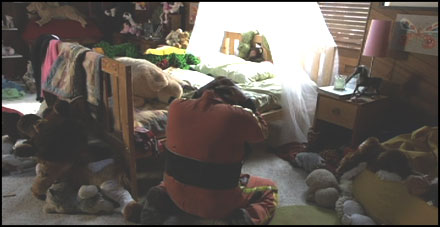
The Chief, stunned and heartbroken, stumbles into their projected dream house. He finds his way into his daughter’s room, but she’s no longer there. The house is an empty shell, the façade it had always been.
The Sonata, lush and romantic on its own, provides painful, bittersweet counterpoint to the visuals. Kara’s father had given up everything he ever had so he could write this piece of music. And now it underscores the pain Tyrol experiences at losing the family he might have had if life had turned out differently. He falls to his knees, a broken man. But, the piano performance, fluttering through half-diminished chords like a butterfly, descends gently to its graceful concluding chord as we fade to black.